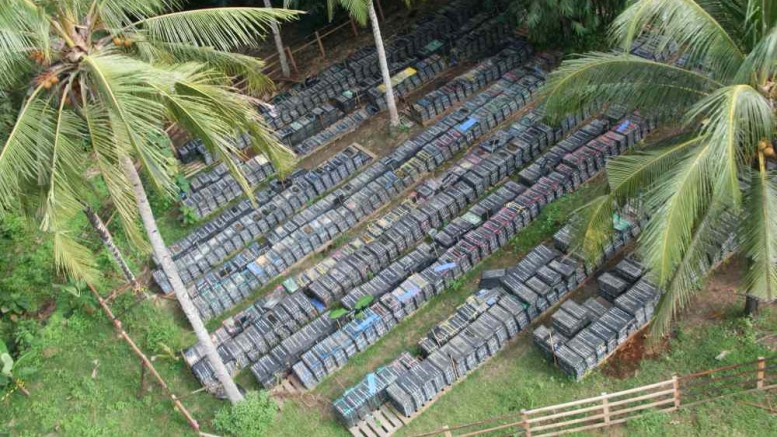Indonesia has confirmed it will ban exports of nickel ore from January 2020 — two years earlier than expected.
The Southeast Asian nation is the world’s largest nickel ore producer, and the news unleashed a torrent of speculation about supply shortages. Three-month nickel contracts on the London Metal Exchange (LME) surged as high as US$18,850 per tonne — a five-year peak — on Sept. 2.
While 70% of the world’s nickel goes into stainless steel production, the metal is becoming increasingly important as an ingredient in the cathode part of lithium-ion rechargeable batteries in the emerging electric-vehicle market, an industry Indonesia wants to develop.
“The government decided — after weighing all the pros and cons — that we want to expedite smelter building,” Bambang Gatot Ariyono, Director General for minerals and coal at the Energy and Mineral Resources Ministry, told reporters in Jakarta. “So we took the initiative to stop exports of nickel ores of all quality.
“If we continue free exports, [Indonesia’s] proven reserves will be enough only for seven to eight years,” Bloomberg quoted Ariyono as saying. “The technology is advancing, so smelters can process low-grade nickel ores, and they can be used for batteries to help Indonesia meet its electric-vehicle goals.”
The Indonesian government has issued export permits this year for as much as 38.6 million tonnes of wet nickel ore — or about 375,000 tonnes of refined nickel.
Most of Indonesia’s nickel goes to China, where it’s turned into nickel pig iron (NPI).
As a result, Chinese buyers “will be scouring the globe for suitable ore supply,” Colin Hamilton of BMO Capital Markets said in a note, pointing out that “deposits of nickel saprolite for NPI are relatively rare,” and are mostly found in Indonesia, the Philippines and New Caledonia, although China has started importing some from as far afield as Guatemala.
The London-based analyst also forecasts an “accelerated ramp-up” of Indonesian NPI facilities, and domestic NPI production moving from 360,000 tonnes this year to 480,000 tonnes next year.
Olivier Masson, a senior analyst at Roskill, agrees, explaining that Indonesia was successful in expanding NPI capacity after the country last imposed a ban on nickel exports in 2014. (It relaxed it in 2017, allowing miners to export ore grading less than 1.7% nickel content.)
“Indonesia was very successful in attracting NPI capacity after the 2014 ban and nickel production in the country absolutely surged,” he says in an interview from London, “so they want to do the same thing, but for battery-grade material, which will require building hydrometallurgical plants.”
Wood Mackenzie cautions that while the Philippines is seen as the main source of ore to offset Indonesian nickel, some mines in the island province of Tawi-Tawi “are apparently nearing exhaustion.” One of the country’s biggest nickel mines, SR Languyan, is expected to stop producing this year.
The research and consulting firm forecasts the total loss in nickel production from the export ban will be 16,000 tonnes in 2020, 190,000 tonnes in 2021, 112,000 tonnes in 2022 and 85,000 tonnes from 2023 on. It warned that it doesn’t believe the loss in 2021 “can be offset by increases in output elsewhere,” although from 2022, “the bulk of the lost output could be offset by increased output from Indonesia, assuming funds can be secured for the planned expansions.”
BMO is modelling a nickel market deficit of 51,000 tonnes in 2020 and 127,000 tonnes in 2021, compared to its previously modelled, 26,000-tonne deficit in 2020, and 13,000-tonne surplus in 2021.
Nickel has already been one of the best performing commodities on the LME this year. At press time, nickel prices on the LME were US$17,540 per tonne, and Goldman Sachs forecasts nickel prices could spike to US$20,000 a tonne in three months, before falling back to US$16,000 a tonne within a year.
Ironically, the nickel-export ban may have unintended consequences for Indonesia, because it could become a headwind to demand for battery cathode technology using nickel, analysts like Hamilton speculate.
“Of course, the catalyst for bringing forward the ban was President Joko Widodo’s decree that lays out government support for Indonesia to become Asia’s hub for electric-vehicle production,” Hamilton noted. “However, this development — and the nickel price gains accompanying it — are likely to slow the transition to nickel-rich cathode, particularly given that cobalt constraints have eased.
“Moreover, it may give Chinese battery producers such as BYD an opening to push nickel-free, lithium-ion phosphate batteries in China once more, particularly as reduced electric-vehicle subsidies for NMC [nickel, manganese, cobalt] technology has made them more competitive again, for low-range vehicles.”





Be the first to comment on "Editorial: Indonesia to ban nickel ore exports in 2020"